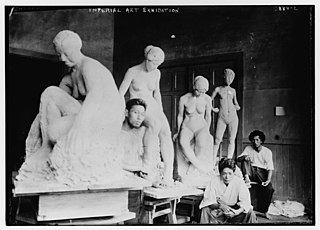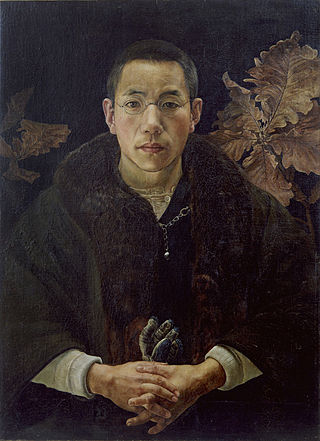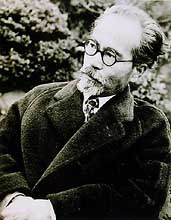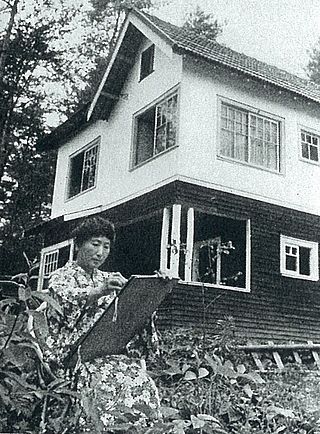
Tarō Okamoto was a Japanese artist, art theorist, and writer. He is particularly well known for his avant-garde paintings and public sculptures and murals, and for his theorization of traditional Japanese culture and avant-garde artistic practices.

Toko Shinoda was a Japanese artist. Shinoda is best known for her abstract sumi ink paintings and prints. Shinoda's oeuvre was predominantly executed using the traditional means and media of East Asian calligraphy, but her resulting abstract ink paintings and prints express a nuanced visual affinity with the bold black brushstrokes of mid-century abstract expressionism. In the postwar New York art world, Shinoda's works were exhibited at the prominent art galleries including the Bertha Schaefer Gallery and the Betty Parsons Gallery. Shinoda remained active all her life and in 2013, she was honored with a touring retrospective exhibition at four venues in Gifu Prefecture to celebrate her 100th birthday. Shinoda has had solo exhibitions at the Seibu Museum at Art, Tokyo in 1989, the Museum of Fine Arts, Gifu in 1992, the Singapore Art Museum in 1996, the Hara Museum of Contemporary Art in 2003, the Sogo Museum of Art in 2021, the Tokyo Opera City Art Gallery in 2022, and among many others. Shinoda's works are in the collection of the Albright-Knox Art Gallery, the Art Institute of Chicago, the British Museum, the Brooklyn Museum, the Harvard Art Museums, the Metropolitan Museum of Art, the Museum of Fine Arts, Boston, the National Museum of Modern Art, Tokyo, the Singapore Art Museum, the Smithsonian Institution, the Solomon R. Guggenheim Museum, the National Gallery of Victoria, and other leading museums of the world. Shinoda was also a prolific writer published more than 20 books.

The Japan Fine Arts Exhibition is a Japanese art exhibition established in 1907. The exhibition consists of five art faculties: Japanese Style and Western Style Painting, Sculpture, Craft as Art, and Sho (calligraphy). During each exhibition, works of the great masters are shown alongside works of new but talented artists. It claims to be the largest combined art exhibition of its kind in the world and the most popular in Japan.

Kenzo Okada was a Japanese-born American painter and the first Japanese-American artist working in the Abstract Expressionist style to receive international acclaim. At the 29th Venice Biennale in 1958, Okada’s work was exhibited in the Japan Pavilion and he won the Astorre Meyer Prize and UNESCO Prize.
Ei-Q was a Japanese artist who worked in a variety of media, including photography and engraving.

Kohno Michisei was a Japanese painter, illustrator, and printmaker known for his association with the yōga movement of the early 20th century. His work is considered representative of the Taishō period in Japanese art.
Minoru Kawabata was a Japanese artist. Kawabata is best known for his color field paintings. Between 1960 and 1981, Kawabata had 11 solo shows at the prominent Betty Parsons Gallery in New York. At the 31st Venice Biennale in 1962, Kawabata’s work was exhibited in the Japan Pavilion alongside that of four other Japanese artists. Kawabata has had solo exhibitions at the Everson Museum of Art in 1974, the Museum of Modern Art, Kamakura in 1975, the National Museum of Modern Art, Kyoto and Ohara Museum of Art in 1992, and Yokosuka Museum of Art in 2011. Kawabata’s works are in the collection of the Albright-Knox Art Gallery, Artizon Museum, Everson Museum of Art, Museum of Contemporary Art Tokyo, the Museum of Modern Art, Kamakura & Hayama, the Museum of Modern Art, São Paulo, the National Museum of Art, Osaka, the National Museum of Modern Art, Kyoto, the National Museum of Modern Art, Tokyo, the Newark Museum of Art, Ohara Museum of Art, Solomon R. Guggenheim Museum, Yokohama Museum of Art, Yokosuka Museum of Art, among others.

Ryumon Yasuda was a Japanese painter and sculptor.
Shigeru Nakanishi is a Japanese artist from Tokyo, Japan.
The Museum of Modern Art, Kamakura & Hayama is the first public modern art museum in Japan. The museum consists of three halls: Kamakura, Kamakura annex, and Hayama.

Keiko Minami was a Japanese artist, aquatint engraver, and poet. She is best known for her pictograph-like aquatints with a whimsical, childlike aesthetic.
Madokoro Akutagawa Saori was a Japanese painter whose works were often associated with primitivism, folkloric and mythological subjects, as well as unique dyeing techniques. Her paintings from the 1950s manifest various themes from distorted and dramatic portrayal of women to divine narratives based on traditional Japanese folklore. After briefly studying and living in the US, Akutagawa shifted her artistic exploration towards abstraction before her death at a young age in 1966.

Migishi Setsuko was a Japanese yōga (Western-style) painter. Known for employing vivid colors and bold strokes for still-life and landscape, Migishi contributed greatly to the establishment and elevation of the status of female artists in the Japanese art scene.
Katsuhiro Yamaguchi was a Japanese artist and art theorist based in Tokyo and Yokohama. Through his collaborations, writings, and teaching, he promoted an interdisciplinary avant-garde in postwar Japan that served as the foundation for the emergence of Japanese media art in the early 1980s, a field in which he remained active until his death. He represented Japan at the 1968 Venice Biennale and the 1975 Bienal de São Paulo, and served as producer for the Mitsui Pavilion at Expo '70 in Osaka.
Hideko Fukushima, born Aiko Fukushima, was a Japanese avant-garde painter born in the Nogizaka neighborhood of Tokyo. She was known as both a founding member of the Tokyo-based postwar avant-garde artist collective Jikken Kōbō and was recruited into Art Informel circles by the critic Michel Tapié during his 1957 trip to Japan. As a member of Jikken Kōbō she participated in art exhibitions, designed visuals for slide shows and costumes and set pieces for dances, theatrical performances, and recitals. She contributed to the postwar push that challenged both the boundaries between media and the nature of artistic collaboration, culminating in the intermedia experiments of Expo '70.
Akira Itō is a Japanese post-war and contemporary Nihonga painter.
Yoshishige Saitō was a Japanese visual artist and art educator.
Toeko Tatsuno was a Japanese abstract painter, printmaker, and former professor at Tama Art University in Japan.
Yasue Kodama (児玉靖枝) is a Japanese artist born in Hyogo in 1961. She graduated from the Kyoto City University of Arts with a B.A. in Oil Painting in 1984 and an M.A. in painting in 1986. Kodama's early works consist primary of still life works but she shifted to more abstract works in the 1990s but then turns back towards the representational in the 2000s. She has received various awards throughout her career, such as the 34th Kyoto Fine Arts and Culture Award in 2021, and has participated numerous group exhibition such as VOCA: Vision of Contemporary Art exhibitions and Monet's Legacy at the Yokohama Museum of Art in 2018. Her works are included in various public collections across Japan. She has also taught painting at her alma mater, the Kyoto City University of Arts.

Yoshio Fujimaki (January 19, 1911 – disappeared September 2, 1935)was a Japanese printmaker who was part of the Sōsaku-hanga movement. He focused mainly on depicting the Shitamachi area of Tokyo during the 1930s, and is known for creating a long Hakubyō scroll print focusing on areas surrounding the Sumida River. Fujimaki became an obscure figure after his disappearance at the age of 24, but a 1978 exhibition renewed interest in his work.








